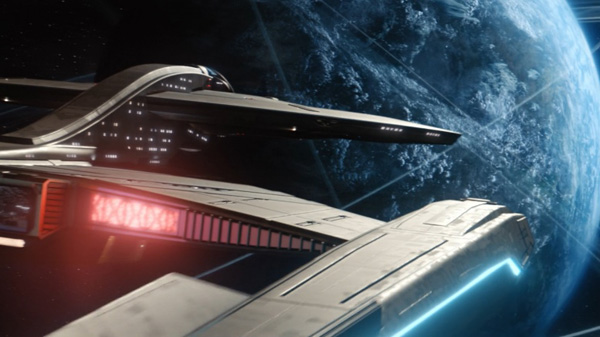
Star Trek: Discovery returns for Season Two!
After a long drought since the cancellation of Star Trek: Enterprise in 2005, Star Trek returned to TV last year with the launch of Star Trek: Discovery on CBS All Access. I was very excited, and while the new show started off strong, I wound up being quite disappointed by the very uneven first season. The show looked great and had a strong cast, but I thought the storytelling was a mess, and the show made a hash of established Star Trek continuity (causing me to ask, again and again, why the show was a prequel when they seemed to have no interest in connecting with the look and feel of the Original Series in any way. Why not just set this show a few decades AFTER Next Gen/DS9/Voyager, thus freeing them up to do whatever they wanted with the show??) But I thought the four Short Trek short films released in the last few months were all very strong, and so I entered season two with renewed excitement. Having now seen the first two episodes, what do I think so far?
It’s not bad!
Although the premiere opened with a long “previously-on” assemblage of clips from season one, I was pleased that, for the most part, these new episodes make a clean break with season one’s main stories (the Klingon war and the long journey to the Mirror Universe) to tell a new story, centered on seven mysterious red bursts that have appeared across the galaxy. (I wish they’d skipped that needless and confusing long “previously on” clip assemblage and began, instead, with the wonderful actual first sequence of the first episode: Burnham’s “space: the final frontier” monologue. That would have been a much stronger opening and I wish they’d trusted it to be so.)
The main change from season one is that the villainous Captain Lorca has been replaced by Anson Mount as Captain Christopher Pike. (Captain Pike, of course, was the captain of the Enterprise before Kirk. Pike was played by Jeffrey Hunter in the original pilot for Star Trek, “The Cage,” which was eventually repurposed into the Original Series season one two-part episode “The Menagerie.” In J.J. Abrams’ rebooted Trek films, Captain Pike was played wonderfully by Bruce Greenwood.) What a difference it makes to the entire show to have the captain be a noble, heroic figure, rather than the duplicitous and ends-justify-the-means Lorca! As a long-time Trek fan, I am sensitive to the strong moral core that has been at the foundation of Star Trek since the very beginning. I often felt that was missing from Discovery season one (as well as from the J.J. Abrams films), as I was often unsure whether we were supposed to be agreeing with Lorca’s actions and philosophy or not. Everything feels different (and better) with Pike in the center chair. Here is a captain who embodies the ideals of Starfleet, who won’t ever leave a Starfleet officer behind, who actually cares about the names and opinions of his bridge crew, and who will repeatedly put himself in harm’s way to protect his fellow officers and to serve what he feels is the greater good. I love the way Pike is written, and Anson Mount is terrific in the role so far.
Burnham’s arc in season one was about redeeming herself from her act of mutiny at the start of the Klingon War. Here in season two, they’ve cleverly tied Burnham into the story of the seven red bursts because of her complicated relationship with her step-brother Spock (who has an at-this-point-unexplained connection himself to the red bursts). I like the idea of finding a way to give Burnham a connection to the season’s main story, though the jury’s still out as to whether any of this Spock stuff is going to actually work. (More on that a bit later in this review.) Sonequa Martin-Green remains terrific as this character. She’s smart and loyal and very emotionally present (despite having been raised as a Vulcan). I love how these first two episodes take a number of moments to show us Burnham’s sensitivity and caring side. We see that she’s concerned for how Saru will feel when Captain Pike takes command of the Discovery away from him; we see her connection to Tilly and the way she’s able to support and encourage her; and the dumb scene in the turbolift in which the alien (is that a Saurian?) sneezes on the Enterprise’s acting science officer is redeemed for me somewhat by the caring way Burnham talks to that nonhuman officer.
Saru hasn’t been a focus yet in these first two episodes, but he’s still gotten a number of great moments. It’s nice to see his confidence in the center seat (smoothly taking control of the attempt to capture an asteroid when Pike steps aside); I loved the moment when he reacts to Lt. Bryce’s response to seeing his threat-ganglia emerge; and I loved the sensitive but firm way he is able to supervise and support Tilly in episode two. Doug Jones is so great in this role. Tilly and Stamets also get some good stuff to do. Tilly remains a somewhat tricky character. For the most part I think she’s great and I like the way the show balances her awkwardness with her huge heart. But how does it make any sense that this cadet was allowed to mess around with the dangerous and mysterious asteroid in the ship’s hangar bay all by herself? As for Stamets, I continue to love Anthony Rapp’s work in this part, and I am glad they’re exploring Stamets’ grief over the death of Hugh Culber rather than pretending that nothing bad happened. (I love his “talk less” exchange with Tilly!) On the other hand, every mention of Hugh reminds me how much I hate the decision to kill off that character in season one. If this is all going somewhere and they’re going to resurrect Hugh, I sort of wish they’d hurry up and get there.
After watching all of Discovery season one, I managed to not know any of the names of the other Discovery bridge officers. The show just didn’t care about those characters to give them much of anything interesting to do. That seems to have changed in season two, and I am thankful. I loved the scene in which Pike asks for a round of introductions on the bridge. It appears the writers recognized that even attentive fans like me didn’t even know these characters’ names! Airiam, Owosekun, Detmer, Bryce, and Rhys have all had more to do in these first two episodes than they did in all of season one. Owosekun even got to go on the landing party with Pike and Burnham in episode two! I hope the show continues to pay attention to and flesh out these characters. I like what I see so far.
The show continues to look amazing, as it did in season one. It is a delight to see Trek realized on such an epic scale. We get a ton of gorgeous shots of the Discovery in these episodes (my favorite was the view of the Enterprise from close along the side of Discovery’s hull, so we could see the windows into Discovery on the right side of the screen in the foreground and the Enterprise on the left in the background). We also get to see a ton of different locations in these first two episodes: the asteroid, the crashed Starfleet ship, the pods they use to get through the asteroid field, “New Eden,” and more, and they all look great. I still object to many of the show’s design choices (more on that in a moment) but in terms of the execution, the work is top-notch.
So where are the problems?
Well, my biggest objection is that there’s a laziness to the show’s storytelling that continues to bug me. I like some of the course corrections from season one that I’ve seen so far, as detailed above, but this lack of attention to detail persists and really annoys me. Let’s take the Enterprise’s acting science officer. Why was he portrayed in such a one-dimensional manner as an arrogant prick? If they wanted his death to be surprising and/or moving, then why did they make him be such an over-the-top jerk in every single moment, including the very moment of his death? That’s lazy story-telling. (And unbelievable that Captain Pike would tolerate that asshole in a position of authority on his ship for more than two seconds.)
The premiere episode, “Brother,” directed by Alex Kurtzman, was very much like J.J. Abrams’ Trek movies in that it was thrilling and exciting, but its incredibly fast pace meant it was hard to take in much of what was happening. I love the energy and momentum to the storytelling, but there were times when I wanted the show to slow down and take a breath, and take the time to better explain to us what’s going on. I wanted to know more about the two officers Captain Pike brought with him from the Enterprise (the woman in red and the doomed science officer in blue). I wanted to know more about these red bursts — how was Starfleet able to detect them, if they’re spread out across the known galaxy? What exactly happened to the Enterprise? (I couldn’t tell if the show was being intentionally vague about that because it’s a story they’ll be getting back to, or not. Either way, that we didn’t seem to get a moment of hesitation or regret from Pike in leaving his ship and crew behind was a misstep, in my opinion.) The action sequence in which Burnham, Pike, etc. piloted the small pods to the large asteroid was fast-paced and exciting and looked amazing. But I had a hard time following what exactly was happening, what went wrong on the pods and what the women on Discovery’s bridge did to save Pike. I loved the idea of the sequence and the idea that the “ladies” on Discovery’s bridge saved the day. But if I actually understood better what was happening in the sequence, it’d have been even more effective. Same goes with the sequence at the end of the episode in which they find a way to capture a huge asteroid in the Discovery’s shuttle bay. I love Tilly’s “the power of math!” moment, but I wish the show had taken the time to explain what they were doing and why it was hard to do.
Then there’s the issue of continuity, which has been a problem for this show since the beginning. I’ve written about my overall issues plenty of times before, so let’s just focus on what we see in this episode. I like the look of Pike’s gold uniform, which is a nice modernization of the Original Series style uniforms. I think the shoulders were a bit too big in all of them, but other than that the uniforms looked great and worked on screen. The problem, of course, is that this is a version of the main Original Series uniforms, but Captain Pike in “The Cage”/”The Menagerie,” as well as Kirk and co. in the second Trek pilot, “Where No Man Has Gone Before,” wore a different-looking uniform. It’s one thing for the rebooted movies, which are set in another timeline, to ignore those “The Cage” style uniforms in favor of the more commonly-known uniforms used throughout the rest of the Original Series. But Discovery is (supposedly) set in the prime timeline, in continuity with those original episodes. I hate that the Discovery crew-members wear a completely different, wrong-for-this-era uniform, but if I have to I guess I can pretend that OK, this different ship had different uniforms. But to see Pike and co. in the wrong-looking uniforms is really a problem for me and rubs my nose in this continuity problem.
Even moire annoying to me was the look of the original Enterprise corridor, which we see when Burnham stands outside Spock’s quarters. That corridor didn’t look ANYTHING like an Original Series corridor. Just painting a swath of the wall bright red (in, I guess, a lazy attempt to mimic the Original Series’ bright color palette) didn’t do it for me.
And, of course, the jury is still out on the whole Burnham-Spock thing. It raised fans’ eyebrows (see what I did there?) when the pilot episode of Discovery revealed that Burnham had been raised by Spock’s parents, Sarek and Amanda. How is it that Spock never mentioned his half-sister before?? We’ve been promised an answer to this continuity problem in season two. So I’ll withhold judgment for now, though I will say that I did not like the suggestion we got here that Spock was sort of the villain in this step-sibling relationship, ignoring Burnham and closing the door on her (end-of-The-Godfather-style). Burnham does later say that the rift between her and Spock was her fault… so I guess we’ll see. But I am skeptical for now. (I’m also of two minds about the presentation of Sarek. On the one hand, I love this Sarek, who is intelligent and logical but also kind and supportive to Burnham. On the other hand, why would a Sarek who is able to be so understanding to Burnham be so cold at the same time to his biological son, Spock? As depicted in the Original Series episode “Journey to Babel,” Sarek and Spock didn’t speak for decades during this era, because Sarek disapproved of Spock’s decision to join Starfleet. And yet, Sarek is depicted on Discovery as being totally supportive of Burnham who is in Starfleet. So this doesn’t really seem to track…)
Other comments on the season premiere, “Brother”:
I loved Tig Notaro’s guest appearance as the engineer of the U.S.S. Hiawatha. She was great! I’d thought/hoped that she’d be joining the Discovery cast, but we didn’t see her at all in episode two. I hope she returns and this wasn’t a one-off appearance.
I like that Pike comments on the ridiculousness of Lorca’s standing-room-only ready room. And the reference to “The Cage” in the fortune-cookie fortune that Pike found was a nice nod.
We see the Discovery get damaged by the asteroids in an exciting sequence — but then the Discovery doesn’t show any damage in any shot of the ship afterwards! Oops.
I was surprised to see all those candles burning in Burnham’s quarters — and I loved the reveal, when she blew one out, that they were all holographic! Nice.
Is Stamets’ ethnobotanist friend on the Enterprise meant to be Sulu…?
I enjoyed the way Saru’s keen sense of smell enabled him to see through Burnham. On the other hand, the suggestion that his vision is sharper than even the ship’s computers was ludicrous.
The glimpse of the exterior of the Discovery’s turboshaft was… interesting. The shot looked cool, but how is there so much empty space inside the Discovery? That doesn’t track to me for an Original Series era starship.
Other comments on episode two, “New Eden”:
I liked that this was basically a stand-alone episode. I liked the mystery of this group of primitive humans on a planet in the Beta Quadrant. I liked the moral dilemma that Pike and Burnham had to wrestle with.
I’m a little bit shocked that Stamets was willing to get back into the Spore Drive chamber… and also that Captain Pike was willing to so quickly go along with that idea without any questioning of how it was possible and what effects it’d have on Stamets. Also, I’d sort of hoped the Spore Drive would have been left behind in season one. Every time Discovery uses it to magically beam across the universe, it emphasizes for me the continuity problem of this amazingly advanced technology being utilized by Starfleet in the pre-Original Series era.
I groaned at the extremely awkward exposition in the old woman’s ceremony/speech that told Pike/Burnham/Owosekun everything they (and we, the audience) needed to know about the settlement and its history. It didn’t make any sense that the New Edeners would believe that any group, even from a “Northern” area like Pike and co. pretended to be, wouldn’t know the story of how their community came to the planet! Here again, the show needed to slow down and take its time more, to find a more gradual and subtle way for Pike and co. to insinuate themselves into the group and for them and us to discover the settlement’s history. This huge exposition dump did not work for me at all.
I liked the reference to Arthur C. Clarke.
I was not a fan of Tilly’s mysterious apparently-dead friend May. The Sixth Sense and Fight Club were great movies, but this idea has been way overused in the years since then.
I was interested to see Pike’s openness to religious faith in this episode. We even learn that one of his parents was a professor of comparative religion. (I wasn’t sure that was something that would still exist in 23rd century Star Trek.) This season looks like it’s going to explore science-vs-faith storylines (what with all the “red angel” stuff and all), which could be an interesting foundation for stories if done well. We’ll see.
Overall I am decently satisfied with these first two episodes of Discovery season two, and eager to see where the show goes from here.


